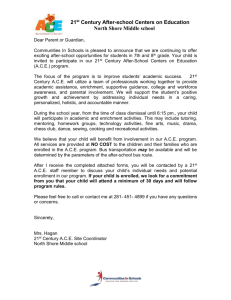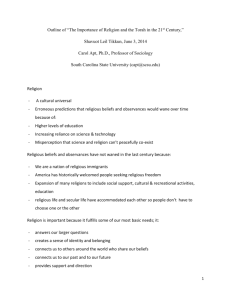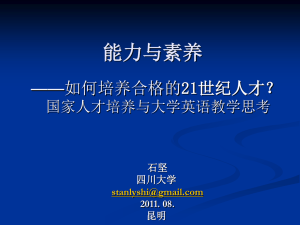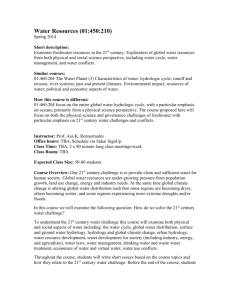21ST CENTURY STUDENT OUTCOMES:
advertisement
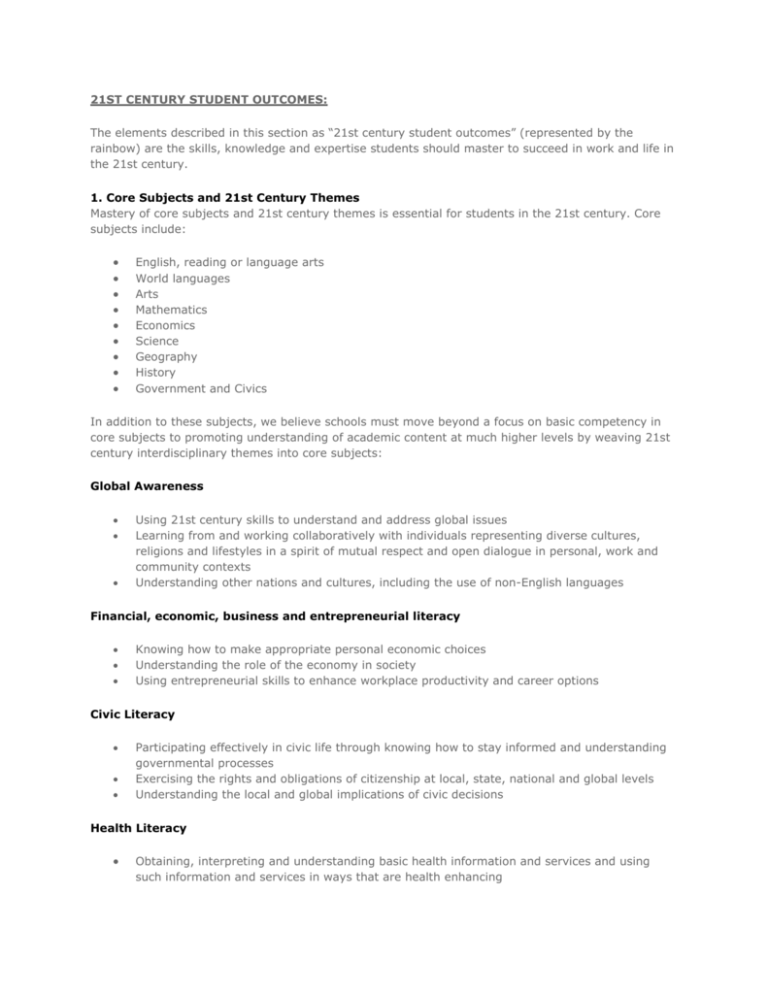
21ST CENTURY STUDENT OUTCOMES: The elements described in this section as “21st century student outcomes” (represented by the rainbow) are the skills, knowledge and expertise students should master to succeed in work and life in the 21st century. 1. Core Subjects and 21st Century Themes Mastery of core subjects and 21st century themes is essential for students in the 21st century. Core subjects include: English, reading or language arts World languages Arts Mathematics Economics Science Geography History Government and Civics In addition to these subjects, we believe schools must move beyond a focus on basic competency in core subjects to promoting understanding of academic content at much higher levels by weaving 21st century interdisciplinary themes into core subjects: Global Awareness Using 21st century skills to understand and address global issues Learning from and working collaboratively with individuals representing diverse cultures, religions and lifestyles in a spirit of mutual respect and open dialogue in personal, work and community contexts Understanding other nations and cultures, including the use of non-English languages Financial, economic, business and entrepreneurial literacy Knowing how to make appropriate personal economic choices Understanding the role of the economy in society Using entrepreneurial skills to enhance workplace productivity and career options Civic Literacy Participating effectively in civic life through knowing how to stay informed and understanding governmental processes Exercising the rights and obligations of citizenship at local, state, national and global levels Understanding the local and global implications of civic decisions Health Literacy Obtaining, interpreting and understanding basic health information and services and using such information and services in ways that are health enhancing Understanding preventive physical and mental health measures, including proper diet, nutrition, exercise, risk avoidance and stress reduction Using available information to make appropriate health-related decisions Establishing and monitoring personal and family health goals Understanding national and international public health and safety issues 2. Learning and Innovation Skills Learning and innovation skills increasingly are being recognized as the skills that separate students who are prepared for increasingly complex life and work environments in the 21st century, and those who are not. A focus on creativity, critical thinking, communication and collaboration is essential to prepare students for the future. Creativity and Innovation Demonstrating originality and inventiveness in work Developing, implementing and communicating new ideas to others Being open and responsive to new and diverse perspectives Acting on creative ideas to make a tangible and useful contribution to the domain in which the innovation occurs 3. Information, Media and Technology Skills Information Literacy Accessing information efficiently and effectively, evaluating information critically and competently and using information accurately and creatively for the issue or problem at hand Possessing a fundamental understanding of the ethical/legal issues surrounding the access and use of information Media Literacy Understanding how media messages are constructed, for what purposes and using which tools, characteristics and conventions. Examining how individuals interpret messages differently, how values and points of view are included or excluded and how media can influence beliefs and behaviors. Possessing a fundamental understanding of the ethical/legal issues surrounding the access and use of information ICT Literacy Using digital technology, communication tools and/or networks appropriately to access, manage, integrate, evaluate, and create information in order to function in a knowledge economy Using technology as a tool to research, organize, evaluate and communicate information, and the possession of a fundamental understanding of the ethical/legal issues surrounding the access and use of information 4. Life and Career Skills Today’s life and work environments require far more than thinking skills and content knowledge. The ability to navigate the complex life and work environments in the globally competitive information age requires students to pay rigorous attention to developing adequate life and career skills. Flexibility & Adaptability Adapting to varied roles and responsibilities Working effectively in a climate of ambiguity and changing priorities Initiative & Self-Direction Monitoring one’s own understanding and learning needs Going beyond basic mastery of skills and/or curriculum to explore and expand one’s own learning and opportunities to gain expertise Demonstrating initiative to advance skill levels towards a professional level Defining, prioritizing and completing tasks without direct oversight Utilizing time efficiently and managing workload Demonstrating commitment to learning as a lifelong process Social & Cross-Cultural Skills Working appropriately and productively with others Leveraging the collective intelligence of groups when appropriate Bridging cultural differences and using differing perspectives to increase innovation and the quality of work Productivity & Accountability Setting and meeting high standards and goals for delivering quality work on time Demonstrating diligence and a positive work ethic (e.g., being punctual and reliable) Leadership & Responsibility Using interpersonal and problem-solving skills to influence and guide others toward a goal Leveraging strengths of others to accomplish a common goal Demonstrating integrity and ethical behavior Acting responsibly with the interests of the larger community in mind 21ST CENTURY SUPPORT SYSTEMS: The elements described below are the critical systems necessary to ensure student mastery of 21st century skills. 21st century standards, assessments, curriculum, instruction, professional development and learning environments must be aligned to produce a support system that produces 21st century outcomes for today’s students. 1. 21st Century Standards Focuses on 21st century skills, content knowledge and expertise. Builds understanding across and among core subjects as well as 21st century interdisciplinary themes Emphasizes deep understanding rather than shallow knowledge Engages students with the real world data, tools, and experts they will encounter in college, on the job, and in life--students learn best when actively engaged in solving meaningful problems Allows for multiple measures of mastery 2. Assessment of 21st Century Skills Supports a balance of assessments, including high-quality standardized testing along with effective classroom formative and summative assessments Emphasizes useful feedback on student performance that is embedded into everyday learning Requires a balance of technology-enhanced, formative and summative assessments that measure student mastery of 21st century skills Enables development of portfolios of student work that demonstrate mastery of 21st century skills to educators and prospective employers Enables a balanced portfolio of measures to assess the educational system’s effectiveness at reaching high levels of student competency in 21st century skills 3. 21st Century Curriculum and Instruction Teaches 21st century skills discretely in the context of core subjects and 21st century interdisciplinary themes Focuses on providing opportunities for applying 21st century skills across content areas and for a competency-based approach to learning Enables innovative learning methods that integrate the use of supportive technologies, inquiry- and problem-based approaches and higher order thinking skills Encourages the integration of community resources beyond school walls 4. 21st Century Professional Development Highlights ways teachers can seize opportunities for integrating 21st century skills, tools and teaching strategies into their classroom practice — and help them identify what activities they can replace/de-emphasize. Balances direct instruction with project-oriented teaching methods Illustrates how a deeper understanding of subject matter can actually enhance problemsolving, critical thinking, and other 21st century skills. Enables 21st century professional learning communities for teachers that models the kinds of classroom learning that best promotes 21st century skills for students Cultivates teachers’ ability to identify students’ particular learning styles, intelligences, strengths and weaknesses Helps teachers develop their abilities to use various strategies (such as formative assessments) to reach diverse students and to create environments that support differentiated teaching and learning Supports the continuous evaluation of students’ 21st century skills development Encourages knowledge sharing among communities of practitioners, using face-to-face, virtual and blended communications Uses a scalable and sustainable model of professional development 5. 21st Century Learning Environments Creates learning practices, human support and physical environments that will support the teaching and learning of 21st century skill outcomes Supports professional learning communities that enable educators to collaborate, share best practices and integrate 21st century skills into classroom practice Enables students to learn in relevant, real world 21st century contexts (e.g., through projectbased or other applied work) Allows equitable access to quality learning tools, technologies and resources Provides 21st century architectural and interior designs for group, team and individual learning. Supports expanded community and international involvement in learning, both face-to-face and online



